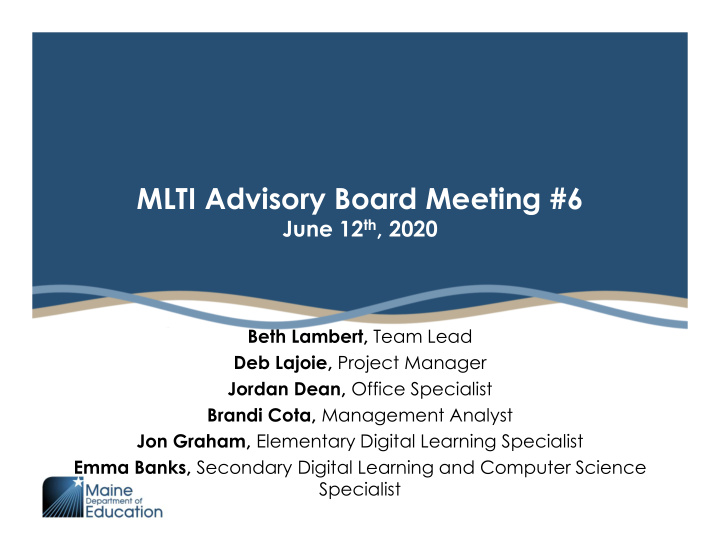



MLTI Advisory Board Meeting #6 June 12 th , 2020 Beth Lambert, Team Lead Deb Lajoie, Project Manager Jordan Dean, Office Specialist Brandi Cota, Management Analyst Jon Graham, Elementary Digital Learning Specialist Emma Banks, Secondary Digital Learning and Computer Science Specialist
AGENDA Welcome and update from Maine DOE 12:30pm: Opening activity 1-2:20pm: Equity stance protocol 2:20-3pm: Implications for the MLTI program
Equity Activity Scenario: Imagine a time when, due to forces beyond our control, school buildings have been closed and education has moved into a period of distance learning for all students. The State has committed to providing a Chromebook for every student. Step 1: Think about your situation and consider how you would change, if at all, the state’s plan to address your unique situation. Step 2: Go around the room and share your situation and how you would change the state’s plan, if at all. DO NOT COMMENT ON EACH OTHER PEOPLE’S YET – let everyone share FIRST. Step 3: Then go around the room – everyone gets a chance to speak – and share reactions and try to come up with a state plan that would address all the situations. RETURN AT 12:50
Equity stance protocol 1. Introduction to Equity Stances - 5 Minutes 2. Read Stances and Write - 10 Minutes 3. Three Levels Protocol - 25 Minutes 4. Full Group Discussion - 40 Minutes
Equity Stances Activity: Essential Question for the Equity Stances Activity: How should Maine DOE redesign the MLTI program to best address the student digital divide?
Stance A: Equity as Initial Equal Opportunity — Maine DOE should guarantee each SAU will receive the same initial allotment of money or services, and that each SAU’s unique situation would be used to determine what additional money or services, if any, it would receive. Example in Practice: Every SAU receives an allotment of money/ services based on a formula. There would be an additional pot of money for SAUs to apply for if their need was greater and that money would be distributed equally
Stance B: Equity as Ongoing Equal Opportunity — Maine DOE should provide each SAU with access to a fund or service to meet specific needs of students in specific situations. Example in Practice: Based on need, Maine DOE would provide devices or internet access to students who need it, like the #ConnectKidsNow! Initiative.
Stance C: Equity as Personalized Opportunity — Maine DOE should provide each SAU with money or services that is well-designed to meet the SAU’s unique needs. Example in Practice: Each SAU creates a plan and applies for funding from Maine DOE, each SAU is eligible for a predetermined amount of money based on a formula.
Stance D: Equity as Equalization of Opportunity — Maine DOE should establish a minimum requirement for the state and prioritize money and services to bring each SAU up that minimum requirement. Example in Practice: Maine DOE determines what the bare minimum is that every SAU must offer their students regarding the digital divide. The state would then provide funding to SAUs who are farthest from that minimum and work to get all SAUs to the minimum.
Stance E: Equity as Equal Results — Maine DOE should guarantee that each SAU will receive the same allotment of money or services to address the digital divide in education. Example in Practice: Maine DOE determines what is the best way to lessen the digital divide, e.g. by providing every student with a laptop. The state then determines how much money they have and equally distributes the laptops to SAUs (like the existing program).
For the next 10 minutes, please read the equity stances to yourself and reflect on which stance. Please write down you initial reactions, questions, and ultimately, which stance you believe best reflects your stance on equity and why.
Three Levels Text Protocol You will complete one round for each person in your group. Each round should take NO MORE than 5 minutes! One person uses up to 3 minutes to: LEVEL 1: read aloud the stance she/he has selected LEVEL 2: say what she/he thinks about the passage (interpretation, connection to past experiences, etc.) LEVEL 3: say what she/he sees as the implications MLTI. The group responds (for a TOTAL of up to 2 minutes) to what has been said. Begin the next round.
Full Group Discussion Where do we stand on equity?
Thank You!
Recommend
More recommend